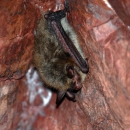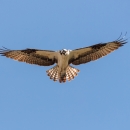Seasons of Wildlife
Winter
Bald eagles, short-eared owls, buffleheads, common goldeneyes, horned grebes, and red-breasted mergansers are also among the cold weather sights. Diving waterfowl are active in the back bays. Wintering songbirds are often sighted along the refuge's many hiking trails. Drive and hike with care as snow and icy patches are often on the roads and trails.
Spring
March, April, and May all see the marsh grasses begin to change from winter’s brown to the green of warmer times. Peepers mating calls in are heard in freshwater habitats; the raucous sounds of the laughing gulls fill the air. Ospreys return from their “winter vacation” in the south and take up residence in the same nest. Osprey Outlook on the refuge boardwalk, complete with telescopes and interpretive panel, provides for outside viewing of an osprey nest. Meanwhile, beach nesting birds arrive as the annual spring migration begins. Watch out for diamondback terrapins, which can be seen bobbing up and down in the creeks. Look for females coming ashore to lay their eggs in the sandy soil. Be careful not to run over them!
Summer
June, July, and August is the time when our feathered families are raised and fledged. Turtles are out and about and can often be sunning themselves in the freshwater ponds. Eastern kingbirds perch on tall flower stems or branches, ready to take flight for an insect meal. Great blue herons, great egrets, and snowy egrets abound. In July, southbound shorebird migration begins. August gives us tree swallows congregating prior to migration. The wax myrtle’s gray berries abound, Staghorn sumac displays a reddish-brown seed, and butterflies feed on the flower nectar. Fiddler crabs and Ghost crabs scamper about during low tide; you can get a great view of them from the boardwalk. Look around when you are near a water control outfall pipe. (There are guardrails at these locations). Striped bass vie with cormorants for baitfish such as Atlantic silversides and mummichogs. These areas are like an aisle in a supermarket and provide the food that other birds and fish need.
Fall
September, October, and November treat us to a variety of birds, butterflies, and colorful plant displays. Leaves change from green to a kaleidoscope of colors until they drop to the ground, leaving bare branches prepared for the approaching winter. Monarch butterflies migrate through the refuge and the land begins to prepare for winter. Soon, ponds will have fringes of ice on their edges. Ducks and geese begin making their way south to Cape May- their winter home.




